Fungus–Fungus Association of Boletus griseus and Hypomyces chrysospermus and Cadmium Resistance Characteristics of Symbiotic Fungus Hypomyces chrysospermus
Abstract
:1. Introduction
2. Material and Methods
2.1. Sampling
2.2. Cd Determination
2.3. Isolation of Mycoparasitic Fungus
2.4. Morphological Identification and Taxonomic Analyses of Mycoparasitic Fungus
2.5. Determination of the Cd Resistance of Mycoparasitic Fungus
2.6. Effects of Cd2+ on the Morphology of Mycoparasitic Fungus
2.7. Effects of Cd2+ on the Growth of Mycoparasitic Fungus
2.8. Cd2+ Absorption by Mycoparasitic Fungus
2.9. Data Analysis
3. Results and Discussion
3.1. Cd Contents in Normal and Deformed Sporocarps of B. griseus
3.2. Isolation and Identification of Mycoparasitic Fungus
3.3. Cd Tolerance of H. chrysospermus
3.4. Cd Absorption by H. chrysospermus
3.5. Effects of Cd on the Growth of H. chrysospermus
4. Conclusions
Author Contributions
Funding
Conflicts of Interest
References
- Mao, X.L. The Macromycetes of China; Science: Beijing, China, 2009; p. 816. [Google Scholar]
- Sun, L.; Chang, W.; Bao, C.; Zhuang, Y. Metal contents, bioaccumulation, and health risk assessment in wild edible Boletaceae mushrooms. J. Food Sci. 2017, 82, 1500–1508. [Google Scholar] [CrossRef]
- Bao, C.J.; Chang, W.D.; Zhuang, Y.L.; Sun, L.P. Nutritional characteristics and protein composition of fruiting bodies of Boletus griseus. J. Food Sci. 2017, 38, 83–89. [Google Scholar] [CrossRef]
- Xiao, J.J.; Li, P.C.; Zhuang, Y.L.; Sun, L.P.; Sun, Y. Multivariate statistics for investigation of factors affecting migrating of cadmium from soil matrix to Boletus griseus. Chin. J. Anal. Chem. 2021, 2, 301–308. [Google Scholar] [CrossRef]
- Falandysz, J.; Borovička, J. Macro and trace mineral constituents and radionuclides in mushrooms: Health benefits and risks. Appl. Microbiol. Biotechnol. 2013, 97, 477–501. [Google Scholar] [CrossRef] [Green Version]
- Seeger, R. Cadmium in Pilzen. Z. Lebensm. Unters. Forsch. 1978, 166, 23–34. [Google Scholar] [CrossRef] [PubMed]
- Drewnowska, M.; Falandysz, J. Investigation on mineral composition and accumulation by popula redible mushroom common chanterelle (Cantharellus cibarius). Ecotox. Environ. Safe 2015, 113, 9–17. [Google Scholar] [CrossRef] [PubMed]
- Borovička, J.; Braeuer, S.; Walenta, M.; Hršelová, H.; Leonhardt, T.; Sácký, J.; Kaňa, A.; Goessler, W. A new mushroom hyperaccumulator: Cadmium and arsenic in the ectomycorrhizal basidiomycete. Thelephora penicillata. Sci. Total Environ. 2022, 826, 154227. [Google Scholar] [CrossRef] [PubMed]
- Borovička, J.; Braeuer, S.; Sáckýd, J.; Kameník, J.; Goessler, W.; Trubač, J.; Strnad, L.; Rohovec, J.; Leonhardt, T.; Kotrba, P. Speciation analysis of elements accumulated in Cystoderma carcharias from clean and smelter-polluted sites. Sci. Total Environ. 2019, 648, 1570–1581. [Google Scholar] [CrossRef] [PubMed]
- Yu, F.Q.; Liu, P.G. Species diversity of wild edible mushrooms from Pinus yunnanensis forests and conservation strategies. Biodivers. Sci. 2005, 13, 58–69. [Google Scholar] [CrossRef]
- Liu, Y.T.; Sun, J.; Luo, Z.Y.; Rao, S.Q.; Su, Y.J.; Xu, R.R.; Yang, Y.J. Chemical composition of five wild edible mushrooms collected from Southwest China and their antihyperglycemic and antioxidant activity. Food Chem. Toxicol. 2012, 50, 1238–1244. [Google Scholar] [CrossRef]
- Wang, X.M.; Zhang, J.; Wu, L.H.; Zhao, Y.L.; Li, T.; Li, J.Q.; Wang, Y.Z.; Liu, H.G. A mini-review of chemical composition and nutritional value of edible wild-grown mushroom from China. Food Chem. 2014, 151, 279–285. [Google Scholar] [CrossRef] [PubMed]
- Liu, B.; Huang, Q.; Cai, H.; Guo, X.; Wang, T.; Gui, M. Study of heavy metal concentrations in wild edible mushrooms in Yunnan Province, China. Food Chem. 2015, 188, 294–300. [Google Scholar] [CrossRef] [PubMed]
- Dowlati, M.; Sobhi, H.R.; Esrafili, A.; FarzadKia, M.; Yeganeh, M. Heavy metals content in edible mushrooms: A systematic review, meta-analysis and health risk assessment. Trends Food Sci. Technol. 2021, 109, 527–535. [Google Scholar] [CrossRef]
- Zheng, J.; Zhang, T.; Fan, J.; Zhuang, Y.; Sun, L. Protective effects of a polysaccharide from Boletus aereus on S180 tumor-bearing mice and its structural characteristics. Int. J. Biol. Macromol. 2021, 188, 1–10. [Google Scholar] [CrossRef] [PubMed]
- Wei, Y.; Li, L.; Liu, Y.; Xiang, S.; Zhang, H.; Yi, L.; Shang, Y.; Xu, W. Identification techniques and detection methods of edible fungi species. Food Chem. 2022, 374, 131803. [Google Scholar] [CrossRef]
- Douhan, G.W.; Rizzo, D.M. Host-parasite relationships among bolete infecting Hypomyces species. Mycol. Res. 2003, 107, 1342–1349. [Google Scholar] [CrossRef]
- Kaygusuz, O.; Çolak, Ö.F.; Türkekul, İ. A new genus record for the macrofungi of Turkey of a fungicolous and mycoparasitic species, Hypomyces chrysospermus Tul. & C. Tul. (Hypocreaceae De Not.). Feddes Repert. 2018, 129, 241–246. [Google Scholar] [CrossRef]
- White, T.J.; Bruns, T.; Lee, S.; Taylor, J. Amplification and Direct Sequencing of Fungal Ribosomal RNA Genes for Phylogeentics. In PCR Protocols: A Guide to Methods and Applications; Innis, M.A., Gelfand, D.H., Sninsky, J.J., White, T.J., Eds.; Academic Press: San Diego, CA, USA, 1990; pp. 315–322. [Google Scholar]
- Khan, A.R.; Waqas, M.; Ullah, I.; Khan, A.L.; Khan, M.A.; Lee, I.-J.; Shin, J.-H. Culturable endophytic fungal diversity in the cadmium hyperaccumulator Solanum nigrum L. and their role in enhancing phytoremediation. Environ. Exp. Bot. 2017, 135, 126–135. [Google Scholar] [CrossRef]
- Albert, Q.; Leleyter, L.; Lemoine, M.; Heutte, N.; Rioult, J.P.; Sage, L.; Baraud, F.; Garon, D. Comparison of tolerance and biosorption of three trace metals (Cd, Cu, Pb) by the soil fungus Absidia cylindrospora. Chemosphere 2018, 196, 386–392. [Google Scholar] [CrossRef]
- Li, X.; Wang, Y.; Pan, Y.; Yu, H.; Zhang, X.; Shen, Y.; Jiao, S.; Wu, K.; La, G.; Yuan, Y.; et al. Mechanisms of Cd and Cr removal and tolerance by macrofungus Pleurotus ostreatus HAU-2. J. Hazard. Mater. 2017, 330, 1–8. [Google Scholar] [CrossRef]
- Vinichuk, M.M. Copper, zinc, and cadmium in various fractions of soil and fungi in a Swedish forest. J. Environ. Sci. Health A Tox Hazard. Subst. Environ. Eng. 2013, 48, 980–987. [Google Scholar] [CrossRef] [PubMed]
- Melgar, M.J.; Alonso, J.; Garcia, M.A. Cadmium in edible mushrooms from NW Spain: Bioconcentration factors and consumer health implications. Food Chem. Toxicol. 2016, 88, 13–20. [Google Scholar] [CrossRef] [PubMed]
- Proskura, N.; Podlasinska, J.; Skopicz-Radkiewicz, L. Chemical composition and bioaccumulation ability of Boletus badius (Fr.) Fr. collected in western Poland. Chemosphere 2017, 168, 106–111. [Google Scholar] [CrossRef] [PubMed]
- Fu, Z.; Liu, G.; Wang, L. Assessment of potential human health risk of trace element in wild edible mushroom species collected from Yunnan Province, China. Environ. Sci. Pollut. Res. Int. 2020, 27, 29218–29227. [Google Scholar] [CrossRef] [PubMed]
- Sarikurkcu, C.; Yildiz, D.; Akata, I.; Tepe, B. Evaluation of the metal concentrations of wild mushroom species with their health risk assessments. Environ. Sci. Pollut. Res. Int. 2021, 28, 21437–21454. [Google Scholar] [CrossRef]
- Riaz, M.; Kamran, M.; Fang, Y.; Wang, Q.; Cao, H.; Yang, G.; Deng, L.; Wang, Y.; Zhou, Y.; Anastopoulos, I.; et al. Arbuscular mycorrhizal fungi-induced mitigation of heavy metal phytotoxicity in metal contaminated soils: A critical review. J. Hazard. Mater. 2021, 402, 123919. [Google Scholar] [CrossRef]
- Tang, Y.; Shi, L.; Zhong, K.; Shen, Z.; Chen, Y. Ectomycorrhizal fungi may not act as a barrier inhibiting host plant absorption of heavy metals. Chemosphere 2019, 215, 115–123. [Google Scholar] [CrossRef]
- Liu, B.; Wang, S.; Wang, J.; Zhang, X.; Shen, Z.; Shi, L.; Chen, Y. The great potential for phytoremediation of abandoned tailings pond using ectomycorrhizal Pinus sylvestris. Sci. Total Environ. 2020, 719, 137475. [Google Scholar] [CrossRef]
- Yu, P.; Sun, Y.; Huang, Z.; Zhu, F.; Sun, Y.; Jiang, L. The effects of ectomycorrhizal fungi on heavy metals’ transport in Pinus massoniana and bacteria community in rhizosphere soil in mine tailing area. J. Hazard. Mater. 2020, 381, 121203. [Google Scholar] [CrossRef]
- Su, Z.Z.; Dai, M.D.; Zhu, J.N.; Liu, X.H.; Li, L.; Zhu, X.M.; Wang, J.Y.; Yuan, Z.L.; Lin, F.C. Dark septate endophyte Falciphora oryzae-assisted alleviation of cadmium in rice. J. Hazard. Mater. 2021, 419, 126435. [Google Scholar] [CrossRef] [PubMed]
- Wang, J.; Chen, R.; Fan, L.; Cui, L.; Zhang, Y.; Cheng, J.; Wu, X.; Zeng, W.; Tian, Q.; Shen, L. Construction of fungi-microalgae symbiotic system and adsorption study of heavy metal ions. Sep. Purif. Technol. 2021, 268, 118689. [Google Scholar] [CrossRef]
- Chu, R.; Li, S.; Zhu, L.; Yin, Z.; Hu, D.; Liu, C.; Mo, F. A review on co-cultivation of microalgae with filamentous fungi: Efficient harvesting, wastewater treatment and biofuel production. Renew. Sustain. Energy Rev. 2021, 139, 110689. [Google Scholar] [CrossRef]
- Liu, J.W.; Ge, Z.W.; Horak, E.; Vizzini, A.; Halling, R.E.; Pan, C.L.; Yang, Z.L. Squamanitaceae and three new species of Squamanita parasitic on Amanita basidiomes. IMA Fungus 2021, 12, 4. [Google Scholar] [CrossRef] [PubMed]
- Traxler, L.; Shrestha, J.; Richter, M.; Krause, K.; Schafer, T.; Kothe, E. Metal adaptation and transport in hyphae of the wood-rot fungus Schizophyllum commune. J. Hazard. Mater. 2022, 425, 127978. [Google Scholar] [CrossRef]
- Gu, S.; Lan, C.Q. Biosorption of heavy metal ions by green alga Neochloris oleoabundans: Effects of metal ion properties and cell wall structure. J. Hazard. Mater. 2021, 418, 126336. [Google Scholar] [CrossRef]
- Soto-Ramirez, R.; Lobos, M.G.; Cordova, O.; Poirrier, P.; Chamy, R. Effect of growth conditions on cell wall composition and cadmium adsorption in Chlorella vulgaris: A new approach to biosorption research. J. Hazard. Mater. 2021, 411, 125059. [Google Scholar] [CrossRef]
- Sharma, K.R.; Giri, R.; Sharma, R.K. Lead, cadmium and nickel removal efficiency of white-rot fungus Phlebia brevispora. Lett. Appl. Microbiol. 2020, 71, 637–644. [Google Scholar] [CrossRef]
- Deng, Z.; Zhang, R.; Shi, Y.; Hu, L.; Tan, H.; Cao, L. Characterization of Cd-, Pb-, Zn-resistant endophytic Lasiodiplodia sp. MXSF31 from metal accumulating Portulaca oleracea and its potential in promoting the growth of rape in metal-contaminated soils. Environ. Sci. Pollut. Res. Int. 2014, 21, 2346–2357. [Google Scholar] [CrossRef]
- Mohammadian, E.; Babai Ahari, A.; Arzanlou, M.; Oustan, S.; Khazaei, S.H. Tolerance to heavy metals in filamentous fungi isolated from contaminated mining soils in the Zanjan Province, Iran. Chemosphere 2017, 185, 290–296. [Google Scholar] [CrossRef]
- Zsigmond, A.R.; Kantor, I.; May, Z.; Urak, I.; Heberger, K. Elemental composition of Russula cyanoxantha along an urbanization gradient in Cluj-Napoca (Romania). Chemosphere 2020, 238, 124566. [Google Scholar] [CrossRef]
- Wang, J.; Lin, L.; Luo, L.; Liao, M.; Lv, X.; Wang, Z.; Liang, D.; Xia, H.; Wang, X.; Lai, Y.; et al. The effects of abscisic acid (ABA) addition on cadmium accumulation of two ecotypes of Solanum photeinocarpum. Environ. Monit. Assess. 2016, 188, 182. [Google Scholar] [CrossRef] [PubMed]
- Tao, Q.; Liu, Y.; Li, M.; Li, J.; Luo, J.; Lux, A.; Kovac, J.; Yuan, S.; Li, B.; Li, Q.; et al. Cd-induced difference in root characteristics along root apex contributes to variation in Cd uptake and accumulation between two contrasting ecotypes of Sedum alfredii. Chemosphere 2020, 243, 125290. [Google Scholar] [CrossRef] [PubMed]
- Ignatova, L.; Kistaubayeva, A.; Brazhnikova, Y.; Omirbekova, A.; Mukasheva, T.; Savitskaya, I.; Karpenyuk, T.; Goncharova, A.; Egamberdieva, D.; Sokolov, A. Characterization of cadmium-tolerant endophytic fungi isolated from soybean (Glycine max) and barley (Hordeum vulgare). Heliyon 2021, 7, e08240. [Google Scholar] [CrossRef] [PubMed]
- Priyadarshini, E.; Priyadarshini, S.S.; Cousins, B.G.; Pradhan, N. Metal-Fungus interaction: Review on cellular processes underlying heavy metal detoxification and synthesis of metal nanoparticles. Chemosphere 2021, 274, 129976. [Google Scholar] [CrossRef]
- Wang, Y.; Yi, B.; Sun, X.; Yu, L.; Wu, L.; Liu, W.; Wang, D.; Li, Y.; Jia, R.; Yu, H.; et al. Removal and tolerance mechanism of Pb by a filamentous fungus: A case study. Chemosphere 2019, 225, 200–208. [Google Scholar] [CrossRef]
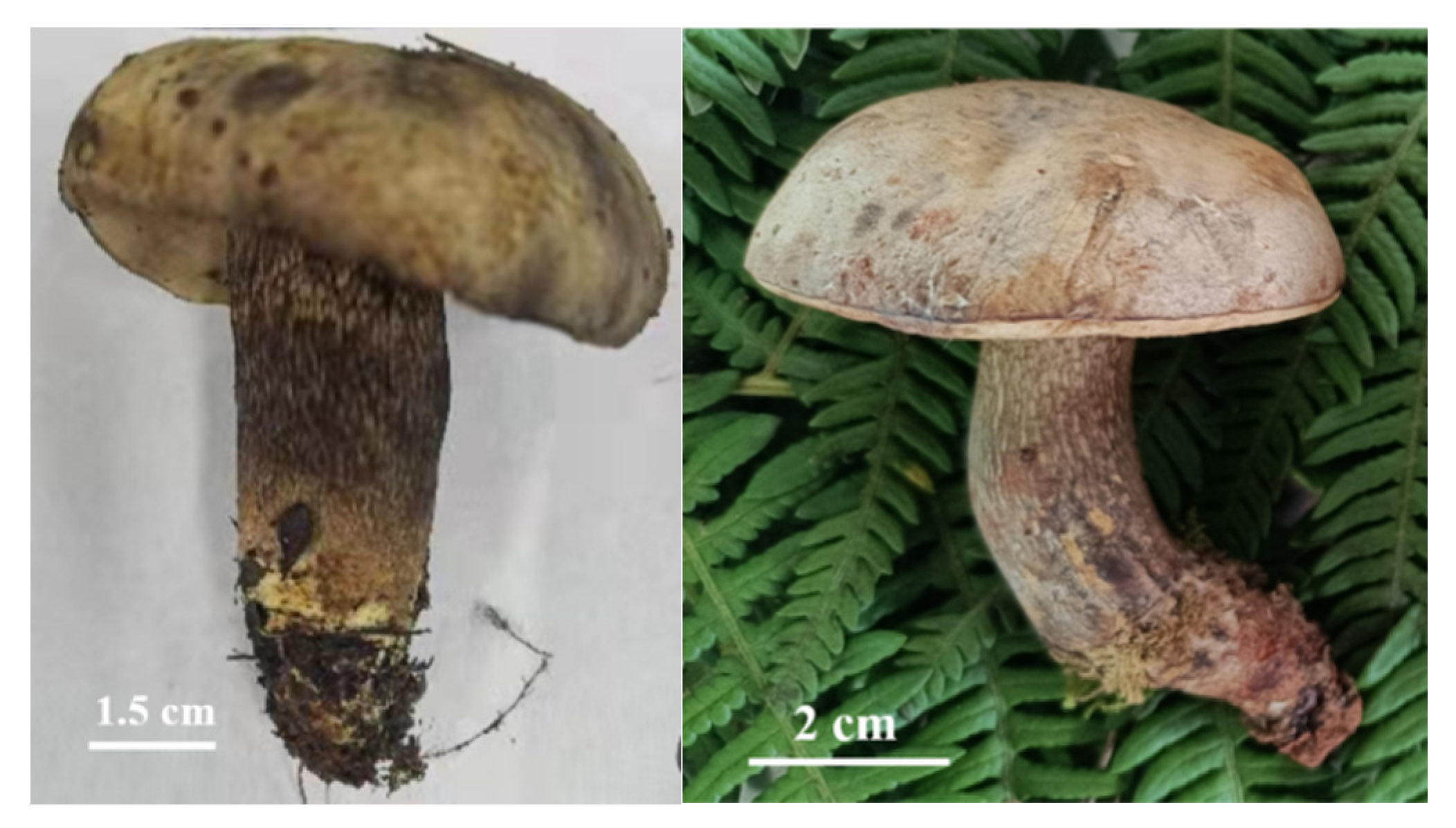

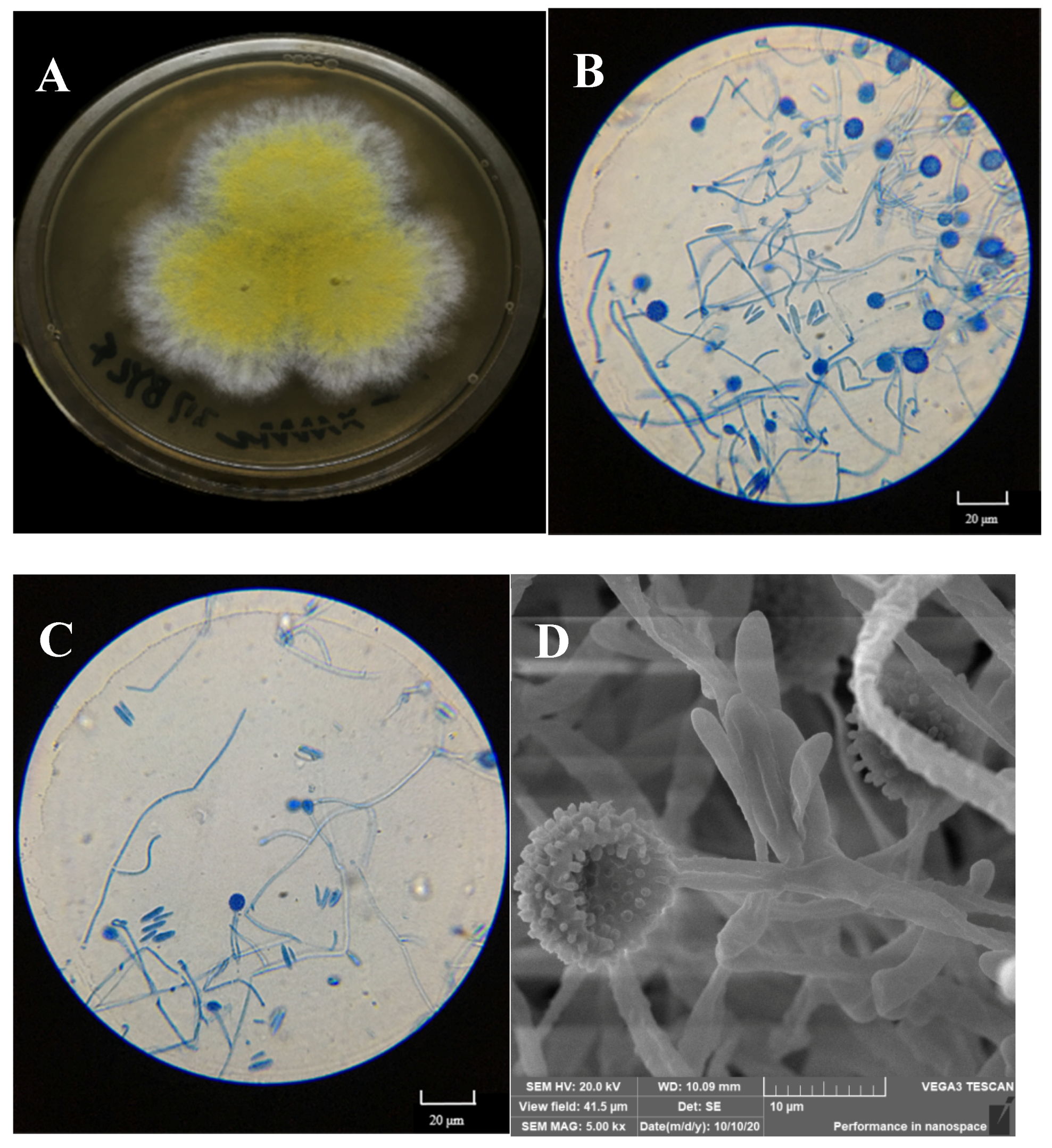
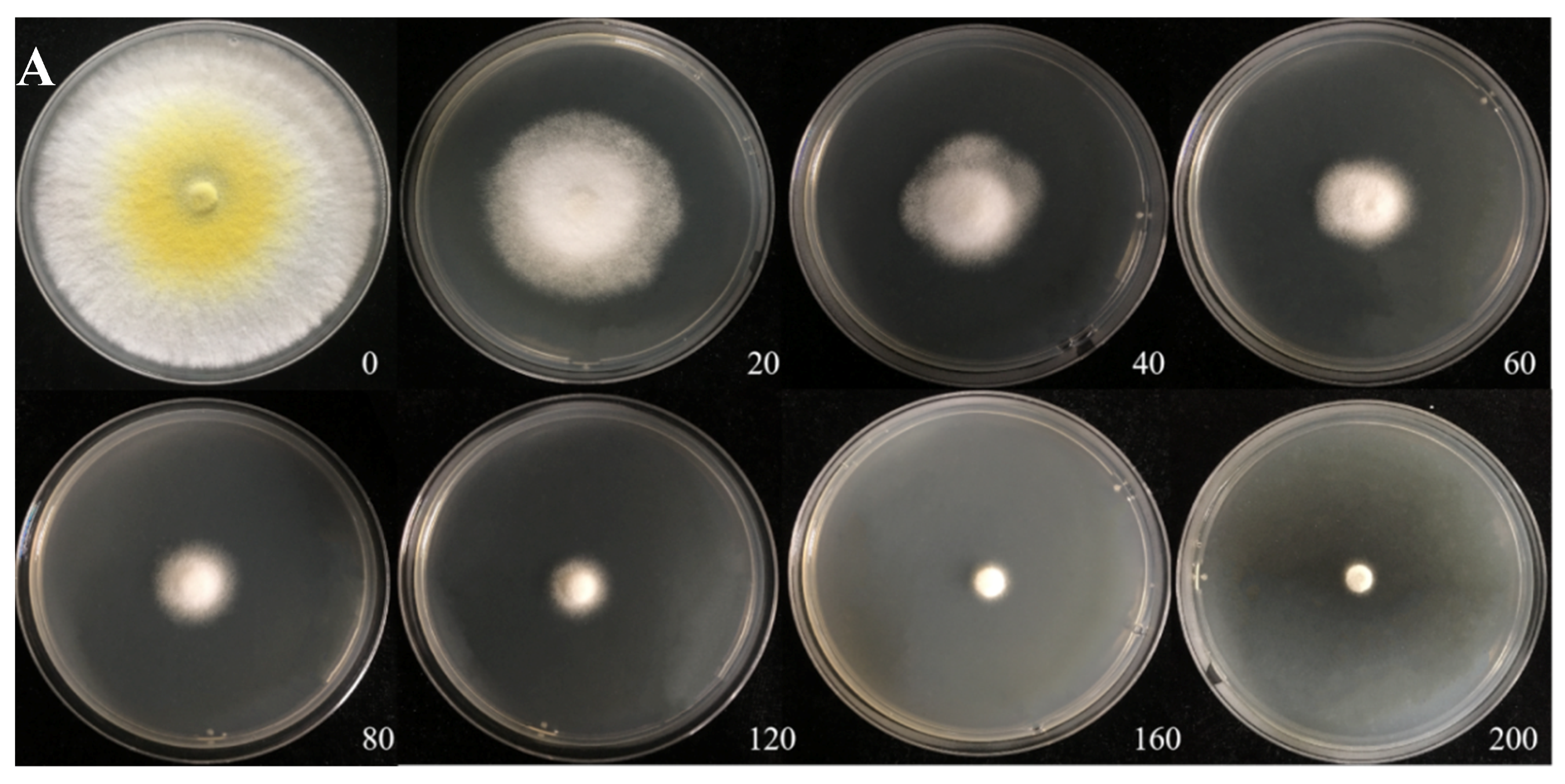
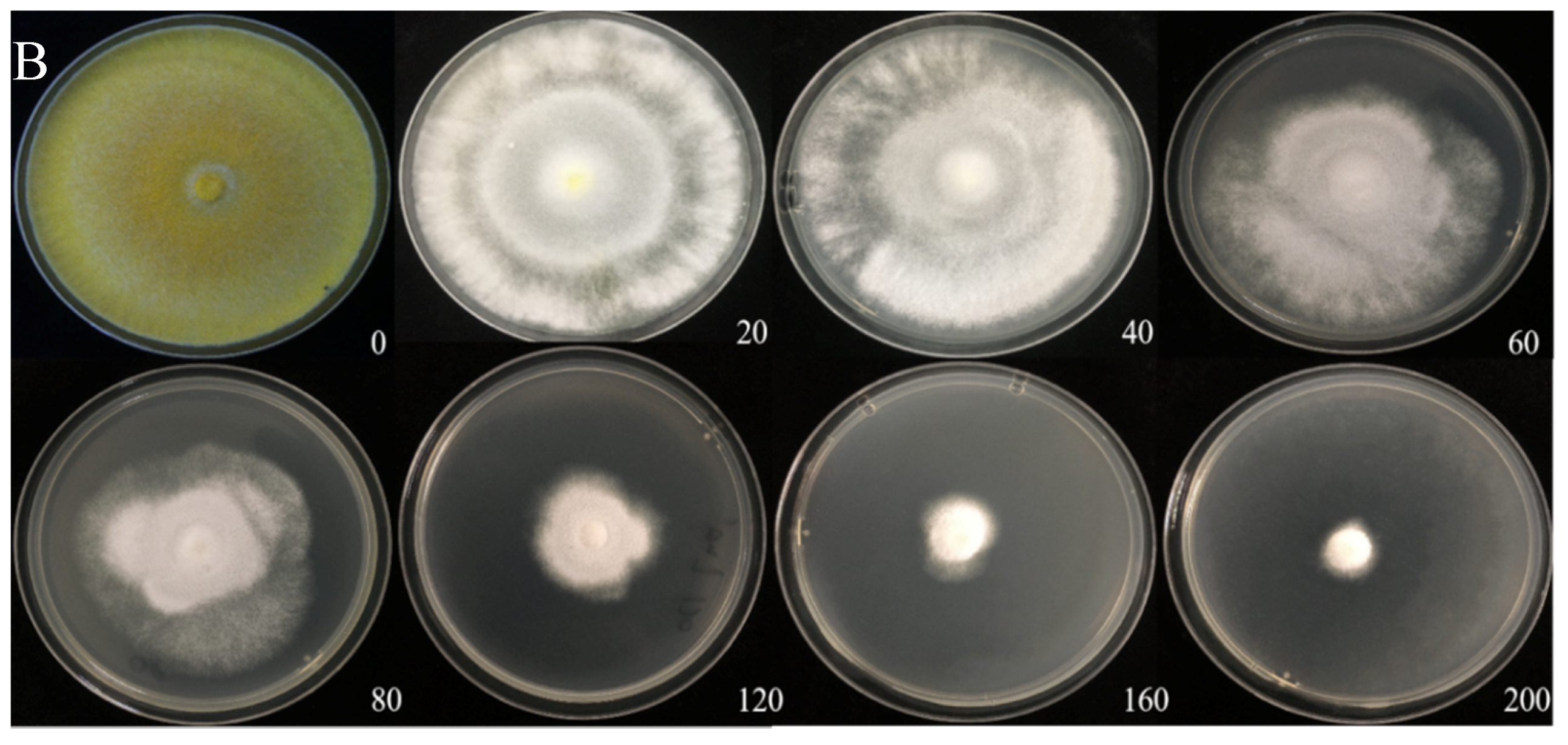
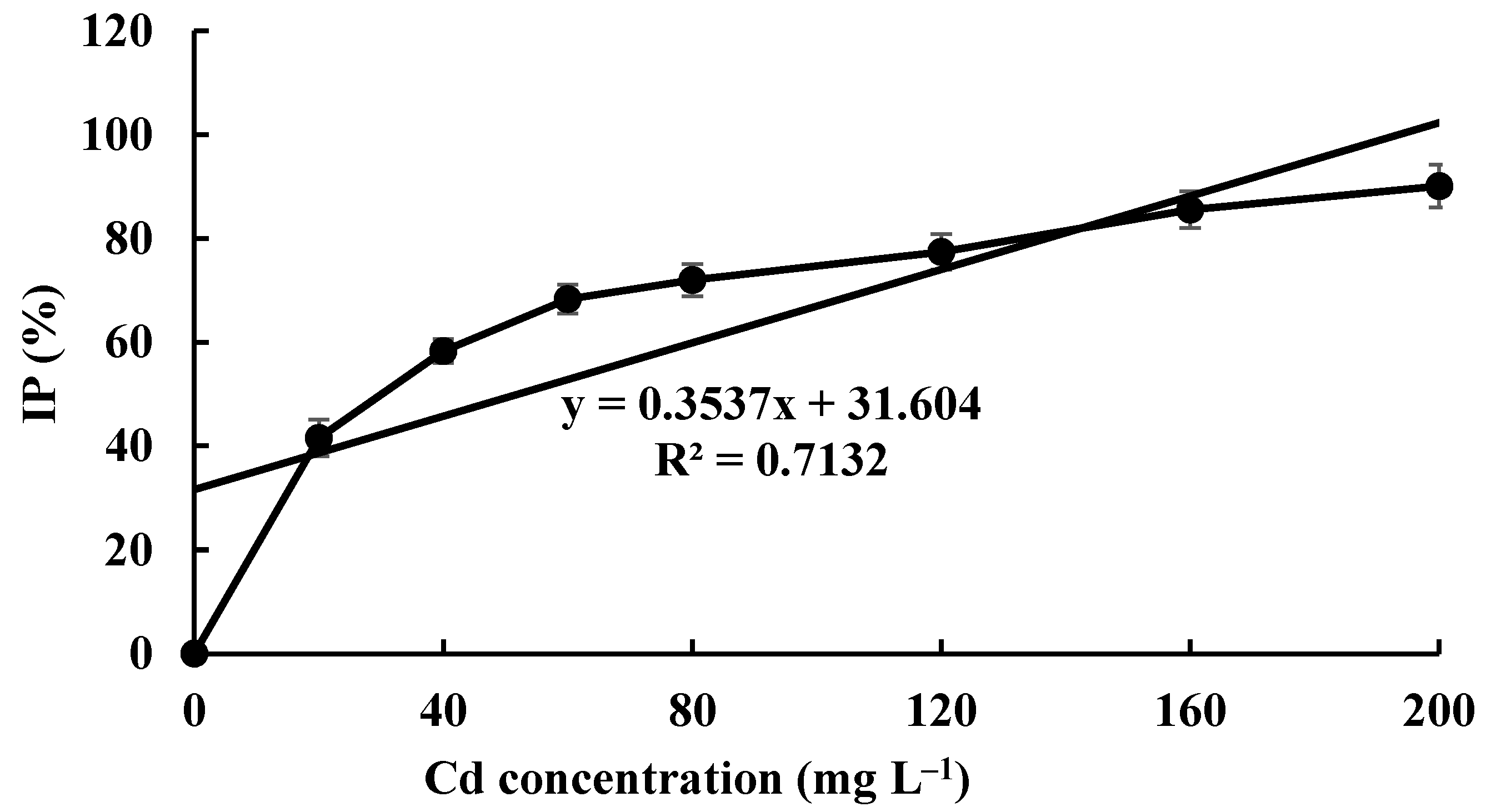


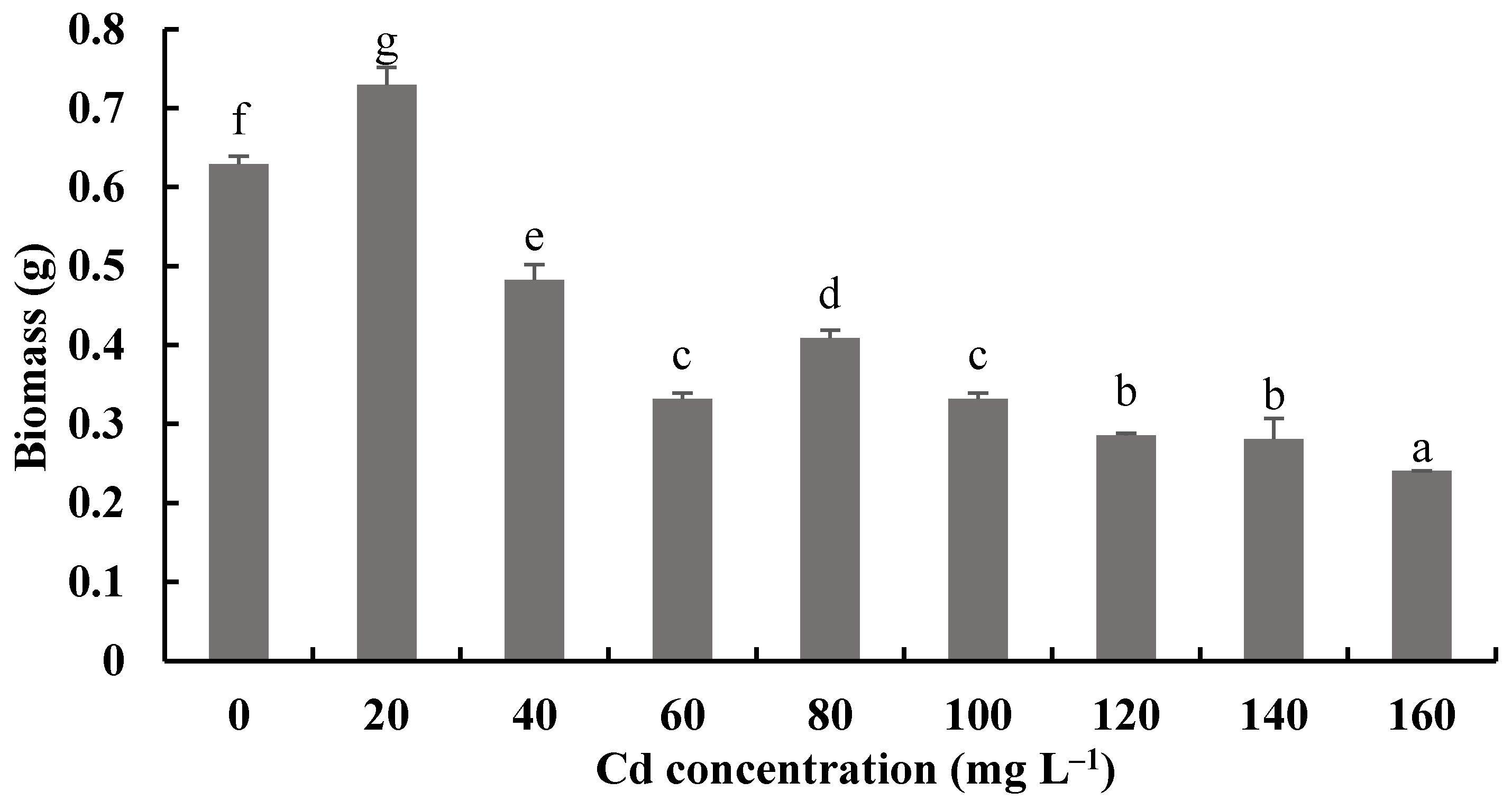

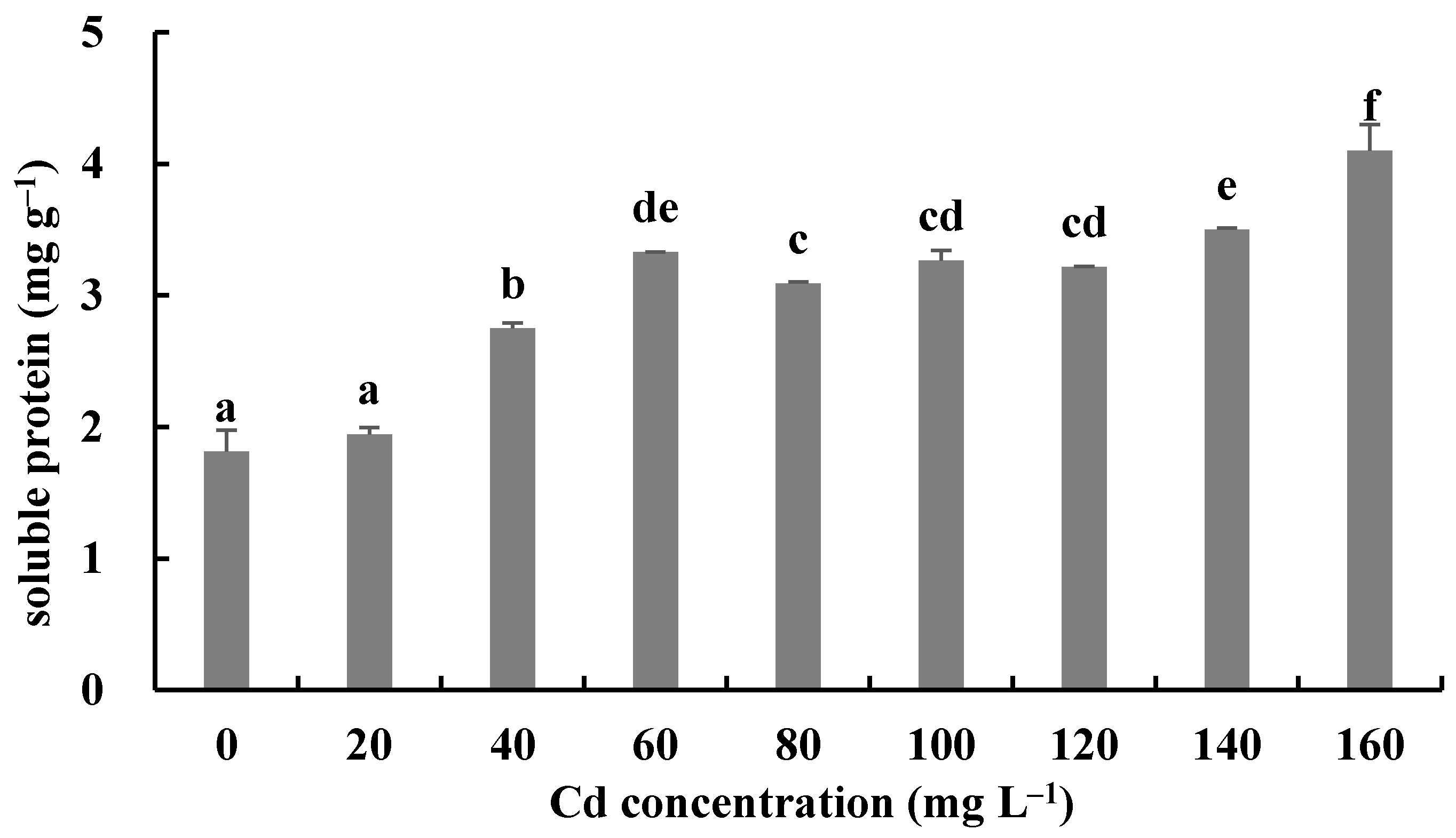
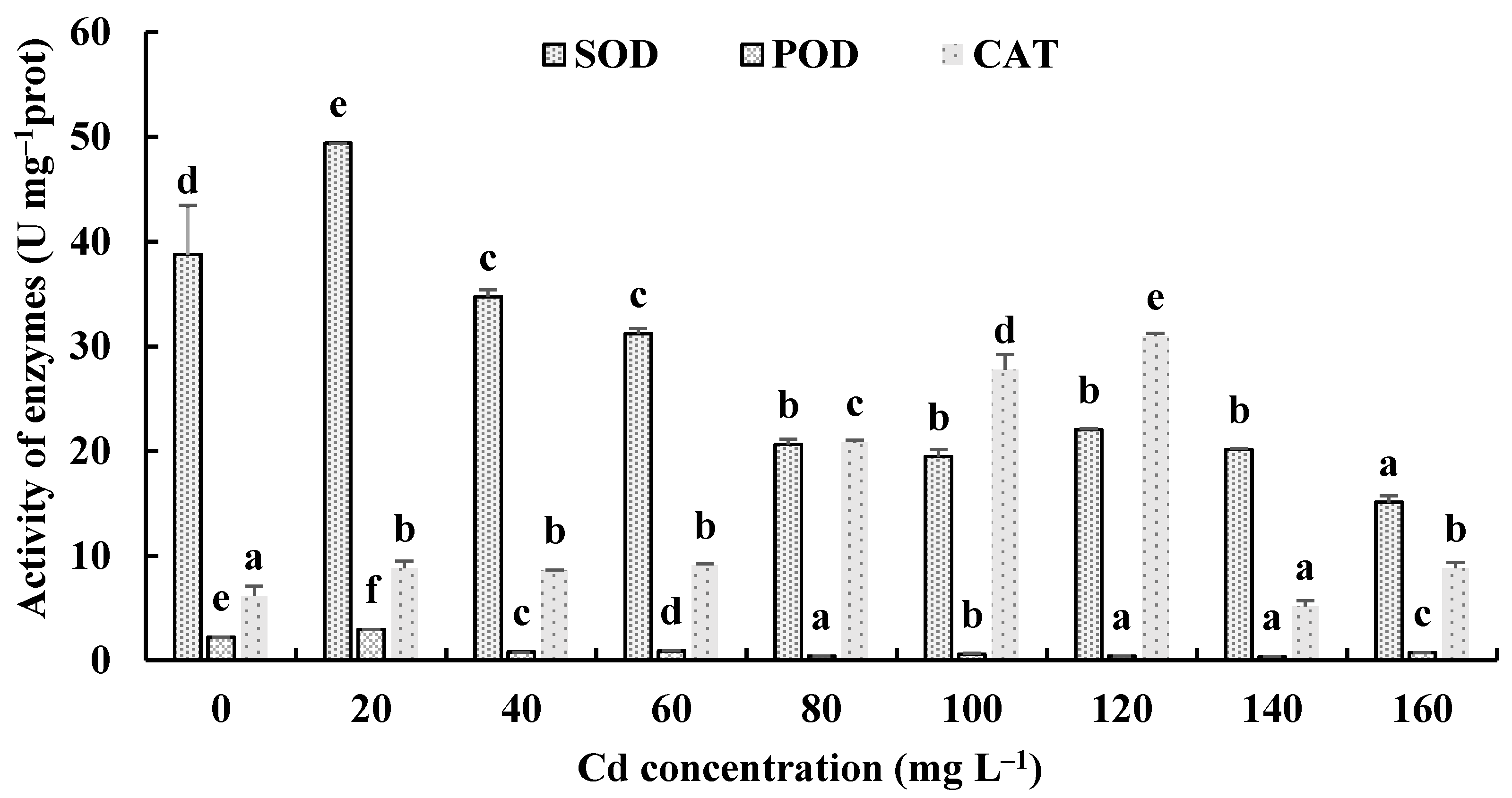
| Sample ID | Normal | Deformed | Sample ID | Normal | Deformed |
|---|---|---|---|---|---|
| 1 | 26.1 ± 0.0 a | 14.9 ± 0.0 b | 13 | 16.1 ± 0.1 b | 35.4 ± 0.0 a |
| 2 | 21.1 ± 4.9 a | 13.5 ± 0.8 b | 14 | 21.3 ± 0.0 a | 16.2 ± 0.1 b |
| 3 | 18.8 ± 1.4 b | 25.3 ± 0.5 a | 15 | 43.4 ± 0.0 b | 44.4 ± 0.1 a |
| 4 | 27.7 ± 1.7 a | 25.6 ± 1.6 a | 16 | 27.5 ± 0.2 b | 49.3 ± 0.9 a |
| 5 | 15.6 ± 0.1 b | 27.6 ± 1.0 a | 17 | 19.3 ± 0.0 b | 19.6 ± 0.0 a |
| 6 | 33.4 ± 0.8 b | 40.3 ± 0.0 a | 18 | 27.2 ± 0.1 b | 36.5 ± 0.6 a |
| 7 | 24.7 ± 0.6 a | 6.4 ± 0.2 b | 19 | 21.3 ± 0.1 b | 24.1 ± 0.1 a |
| 8 | 15.2 ± 0.0 a | 8.4 ± 0.6 b | 20 | 17.8 ± 0.2 b | 33.4 ± 0.1 b |
| 9 | 37.2 ± 1.3 a | 30.2 ± 2.8 b | 21 | 13.7 ± 0.0 a | 10.8 ± 0.1 b |
| 10 | 31.6 ± 2.9 b | 45.8 ± 0.3 a | 22 | 21.4 ± 0.3 a | 21.3 ± 0.2 a |
| 11 | 35.3 ± 0.5 a | 17.9 ± 0.1 b | Average | 24.5 ± 7.9 a | 26.3 ± 12.4 a |
| 12 | 22.1 ± 0.0 b | 31.7 ± 0.3 a |
Publisher’s Note: MDPI stays neutral with regard to jurisdictional claims in published maps and institutional affiliations. |
© 2022 by the authors. Licensee MDPI, Basel, Switzerland. This article is an open access article distributed under the terms and conditions of the Creative Commons Attribution (CC BY) license (https://creativecommons.org/licenses/by/4.0/).
Share and Cite
Tian, Z.; Wang, Y.; Zhuang, Y.; Mao, C.; Shi, Y.; Sun, L. Fungus–Fungus Association of Boletus griseus and Hypomyces chrysospermus and Cadmium Resistance Characteristics of Symbiotic Fungus Hypomyces chrysospermus. J. Fungi 2022, 8, 578. https://doi.org/10.3390/jof8060578
Tian Z, Wang Y, Zhuang Y, Mao C, Shi Y, Sun L. Fungus–Fungus Association of Boletus griseus and Hypomyces chrysospermus and Cadmium Resistance Characteristics of Symbiotic Fungus Hypomyces chrysospermus. Journal of Fungi. 2022; 8(6):578. https://doi.org/10.3390/jof8060578
Chicago/Turabian StyleTian, Zhen, Yunan Wang, Yongliang Zhuang, Chunze Mao, Yujia Shi, and Liping Sun. 2022. "Fungus–Fungus Association of Boletus griseus and Hypomyces chrysospermus and Cadmium Resistance Characteristics of Symbiotic Fungus Hypomyces chrysospermus" Journal of Fungi 8, no. 6: 578. https://doi.org/10.3390/jof8060578







